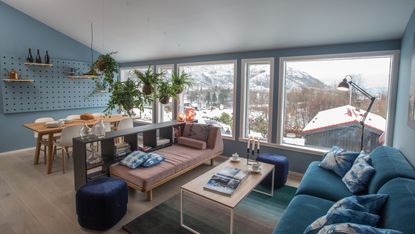Interior designers give their top tips for introducing the biophilic design movement into your home
Biophilic design is transforming the way we live and work; here's how to use it in your home to find balance and reconnect with nature


Biophilic design has taken the world of architecture and interior design trends by storm. What was once a niche interest has grown into a whole movement that aims to transform our built environment by bringing nature back to cities.
As the makers of Biophilic Design: The Architecture of Life, explain it, 'we have often designed our cities and suburbs in ways that both degrade the environment and alienate us from nature.'
Biophilic design draws on our evolutionary need to be close to the natural world and seeks to transform public and private spaces into 'the architecture of life'. It promises to do this by bringing elements of nature into interior design, as well as by opening up interiors to the natural world outside.
We've asked interior designers and architects who specialize in biophilic design to give their top tips for incorporating this progressive and beneficial design into our homes. Here's what they recommend.
1. Make emphasis on green in all its forms

Bancha paint, Farrow and Ball
This is by far the easiest way to incorporate biophilic design principles into your home. Even just adding a few house plants to a room will create a more calming, harmonious environment. However, if house plants are not your style, then using the best green paint is also a way to bring biophilic design into your home. A scientific study has proved that just seeing the color green reduces heart rate and has a calming and relaxing effect on the human organism.
2. Maximize access to natural light

Green House Project, Boca do Lobo
The biophilic movement in design has arisen partly in response to office design that deprives people of natural light and other natural sensory stimuli for hours. Natural light is essential for the correct functioning of our circadian rhythm – the alternating between light and dark that has governed human life for millions of years.
If you are working from home (most of us are at the moment), then make sure that your home working space is positioned next to a window. Oliver Heath, from Oliver Heath Design who have recently launched an online course entitled 'Biophilic Design in the Home', says: 'a “photon shower” (an intense burst of natural light taken each day) will help improve sleep at night and boost alertness during the day. Start by clearing obstructions from windows, be that plants outside, cleaning dirt from the glass but also pulling back curtains and drapes to let the light flood in.
Oliver advises to move furniture as close to windows as you can: 'Light levels one metre from a window will be significantly brighter than even three metres away. So move furniture to maximise time and exposure to natural light within the home. This could be a small sofa or armchair positioned next to a window overlooking the garden, or perhaps move your desk to enhance a view out.'

3. Borrow shapes and design elements from nature

If you want to recreate the harmonious feeling of being in nature at home, think beyond color and light – think about the shapes and different layers and textures of your environment. Zelda Elisco, Sustainable Designer from Abigail-Elise Design Studio, says: 'Curves in our built environment or furniture evoke a positive human reaction because of its resemblance to the natural shapes found in nature.' She further explains that such design choices 'boost the activity of the parasympathetic nervous system, decrease stress levels, and encourage sense of well-being.'
In other words, the biophilic design movement believes there are deeper reasons why that curvy sofa seems so appealing. And it's not just curves that have these positive effects: the 'presence of fractal detail in design reminds us of the many systemic layers of our bodies and our natural environment', says Zelda. 'Fractals are self-similar forms on different scales. The leaves of a fern or the branches of a tree are typical examples. No part of the natural world appears free from them: ocean waves contain smaller waves, etc.' This can be incorporated into home design with a botanical or ocean artwork, or with a living wall insert. Anything that creates layers and imitates nature will work.
Be The First To Know
The Livingetc newsletter is your shortcut to the now and the next in home design. Subscribe today to receive a stunning free 200-page book of the best homes from around the world.

Anna is a professional writer with many years' experience. She has special interests in architecture, photography, and high-end interior design. Her work has appeared in Homes & Gardens, Gardeningetc, and many other publications.
-
 These 12 Best Table Lamps for Your Desk — Perfect Glows for a Creative Home Office
These 12 Best Table Lamps for Your Desk — Perfect Glows for a Creative Home OfficeThe best table lamps for your desk is have a soft, targeted glow. Elevate your WFH set-up with these stylish picks endorsed by Style Editor Brigid Kennedy
By Brigid Kennedy Published
-
 The Nespresso VertuoPlus is 30% Off for President's Day, and it's Kim Kardashian's Coffee Maker of Choice
The Nespresso VertuoPlus is 30% Off for President's Day, and it's Kim Kardashian's Coffee Maker of ChoiceThis sleek and stylish coffee maker was spotted in Kim's home bar, and you can currently save $60 if you buy yours from Amazon
By Lilith Hudson Published

